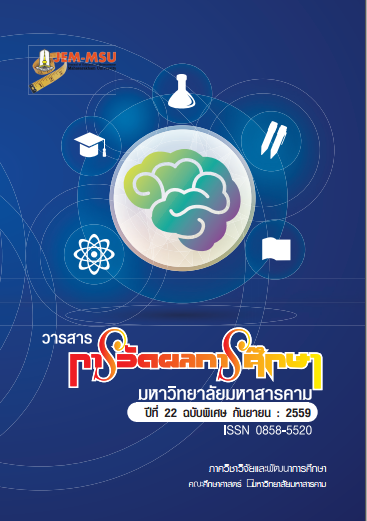The Development of Learning Activities Management in Math Reasoning on Integers System for Matthayomsuksa Taught by Using The Geometer’s Sketchpad as a Media Learning
Main Article Content
Abstract
Mathematics learning activities management attends to develop students’
analytical and synthetical thinking, and also ability to solve mathematical problems.
Teaching mathematics by using The Geometers’ Sketchpad (GSP) focuses on making
students able to discovery knowledge by themselves and encourages students’ attentions.
The geometrical animation, the application of GSP, helps students to understand difficult
content more easily. The purposes of this research were 1) to develop mathematics learning
activities management by using GSP as a media learning and learning activities management
by conventional approach on integers system for Matthayomsuksa 1 students with a
required efficiency of 75/75, 2) to find out the effectiveness indices of those two approach
lesson plans, 3) to compare mathematics learning achievement and mathematical reasoning
ability on integers system of the two groups of Matthayomsuksa 1 students whom taught by
using different learning approaches, and 4) to investigate the students’ satisfaction in the
learning activities management by using GSP as a media learning. The sample in this study
consisted of 42 Matthayomsuksa 1 students from 2 classrooms, selected by cluster random
sampling technique from Banmaisumrong School and Jearavanoneautid 1 School under
Nakhornratchasima Primary Educational Service Area Zone 2. 20 students were assigned for
an experimental group, and 22 students were assigned for a control group. Both of them
studied in the second semester of academic year 2012. The instruments used in this
research consisted of 18 lesson plans from two different learning approaches, using GSP as a
media learning and a conventional approach, a 30-item 4-multiple-choice achievement test
with difficulties ranging at 0.25 to 0.67, discriminating powers ranging at 0.23 to 0.87 and
reliability of 0.87, a 20-item 4-multiple-choice mathematical reasoning ability test with
difficulties ranging at 0.25 to 0.65, discriminating powers ranging at 0.29 to 0.87 and reliability
of 0.78, and a 20-item 5-rating scale test, used for exploring students’ satisfaction in learning
via GSP, with distinguish powers ranging at 3.14 to 9.23 and reliability of 0.77. The statistics
used for analyzing data were percentage, mean, standard deviation, and independent
sample t-test were employed for testing hypotheses.
The results of the study were as follows :
1. The learning activity by using GSP had an efficiency of 83.43/81.67 and the
conventional learning activity had an efficiency of 81.45 /77.12, which were consistent of the
expected requirement as 75/75.
2. The learning activity using GSP had an effectiveness index of 0.7150 and the
conventional learning activity had the effective index of 0.6456.
3. The students who learned using the learning activity by using GSP revealed
higher learning achievement and mathematics reasoning ability than the students who
studied using the conventional learning activity at the .05 level of significance.
4. The students who learned using the learning activity by using GSP had
satisfaction as a whole at a high level.
In conclusion, the learning activity by using GSP was appropriately efficient and
effective. The students were satisfied with the program and had more learning outcomes. It
could by implemented in organization of instruction and learning for the learners according
to achieve objective of the study efficiently and be applied to other related contents.
Article Details
The content and information contained in the published article in the Journal of Educational Measurement Mahasarakham University represent the opinions and responsibilities of the authors directly. The editorial board of the journal is not necessarily in agreement with or responsible for any of the content.
The articles, data, content, images, etc. that have been published in the Journal of Educational Measurement Mahasarakham University are copyrighted by the journal. If any individual or organization wishes to reproduce or perform any actions involving the entirety or any part of the content, they must obtain written permission from the Journal of Educational Measurement Mahasarakham University.


